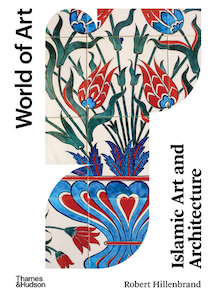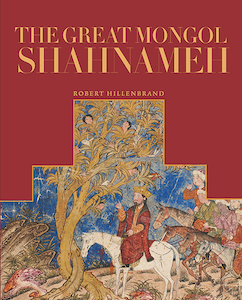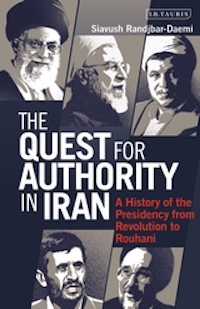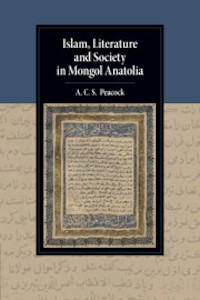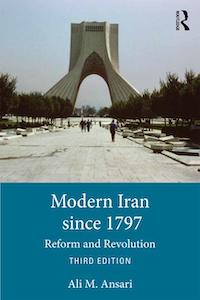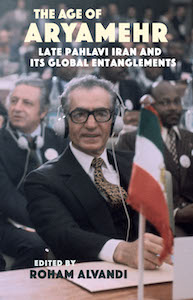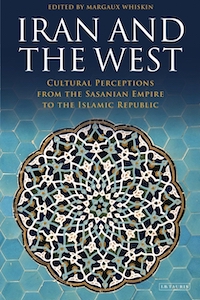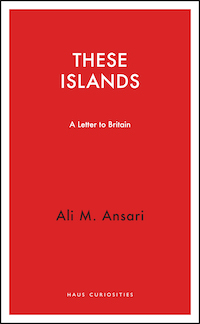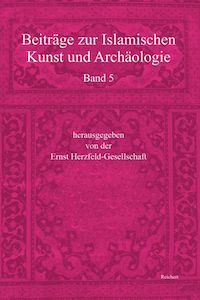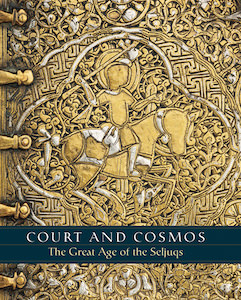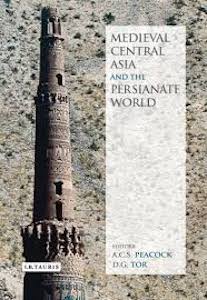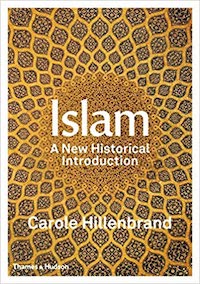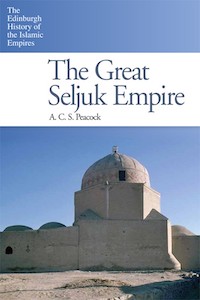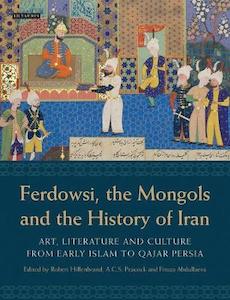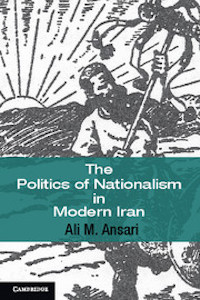Books
The Making of Islamic Art: Studies in Honour of Sheila Blair and Jonathan Bloom
Professor Robert Hillenbrand ed.
In their own words, Jonathan Blair and Sheila Bloom espouse ‘things and thinginess rather than theories and isations’. Its many insights, firmly anchored in artistic practice, are supported by ample technical know-how. This book’s practical, down-to-earth dimension, expressed in plain, simple English, runs counter to the current fashion for theoretical explanations and their accompanying jargon when exploring the world of Islamic art. This bottom–up approach differs radically and refreshingly from that of much top-down contemporary scholarship. It privileges the maker rather than the patron.
May 2021 | Edinburgh University Press
Islamic Art and Architecture New Edition
Professor Robert Hillenbrand
Including over a thousand years of history and stretching from the Atlantic to the borders of India and China, Islamic Art and Architecture is an unparalleled narrative of the arts of Islamic civilization. From the death of the Prophet Muhammad to 1900, Islamic art expert Robert Hillenbrand traces the evolution of an extraordinary range of art forms, including architecture, calligraphy, book illumination, painting, ceramics, glassware, textiles, and metalwork.
February 2021 | Thames and Hudson
The Great Mongol Shahnameh
Professor Robert Hillenbrand
The Great Mongol Shahnameh is widely considered to be the definitive version of Firdausi’s epic poem, and the greatest of all Persian illustrated manuscripts. The paintings from this manuscript are held in private collections and institutions around the world, and have only been seen together in a single volume once since they were originally dispersed. This monograph reunites the paintings and reproduces them as 67 full-page, high quality color plates, alongside an analysis by leading scholar of Islamic art, Robert Hillenbrand. With newly commissioned photographs and insights into technical aspects of the paintings, The Great Mongol Shahnameh is a comprehensive resource for those interested in Persian art and manuscripts.
February 2021 | Hali Publications
Ottoman-Southeast Asian Relations: Sources from the Ottoman Archives (2 vols.)
Dr Ismail Hakkı Kadı (Istanbul Medeniyet University) and Professor Andrew Peacock
The resources published in this study show that the Ottoman Empire was an active actor within the context of Southeast Asian experience with Western colonialism. The fact that the extensive literature on this experience made limited use of Ottoman source materials indicates the crucial importance of this publication for future innovative research in the field.
November 2019 | Brill
The Quest for Authority in Iran: A History of The Presidency from Revolution to Rouhani
Dr Siavush Randjbar-Daemi
Iran’s presidents have defined the Islamic Republic’s attitudes towards the rest of the world. Never has this been more true than now. In this book Siavush Randjbar-Daemi presents an in-depth analysis of the evolution of the Iranian presidency from its inception in the aftermath of the Islamic Revolution to the present day.
November 2019 | I.B.Tauris
Islam, Literature and Society in Mongol Anatolia
Professor Andrew Peacock
From a Christian, Greek- and Armenian-speaking land to a predominantly Muslim and Turkish speaking one, the Islamisation of medieval Anatolia would lay the groundwork for the emergence of the Ottoman Empire as a world power and ultimately the modern Republic of Turkey. Bringing together previously unpublished sources in Arabic, Persian and Turkish, Peacock offers a new understanding of the crucial but neglected period in Anatolian history, that of Mongol domination, between c. 1240 and 1380.
October 2019 | Cambridge University Press
Modern Iran since 1797: Reform and Revolution (3rd Edition)
Professor Ali M Ansari
Modern Iran since 1797 offers a comprehensive analysis of political, social and economic developments in Iran since the end of the eighteenth century. Spanning two centuries, the book provides historical context for Iran’s international relationships and its internal struggle to reconcile itself and its traditions with the modern world.
April 2019 | Routledge
The Age of Aryamehr: Late Pahlavi Iran and its Global Entanglements
Dr Roham Alvandi (LSE) ed.
The history of Pahlavi Iran has traditionally been written as prologue to the 1979 Iranian Revolution and firmly located within a national historical context. However, the reign of the last Shah of Iran, Mohammad Reza Pahlavi (1941-1979), in fact marked the high-point of Iran’s global interconnectedness. Never before had Iranians felt the impact of global political, social, economic, and cultural forces so intimately in their national and daily lives, nor had Iranian actors played such an important global role, on battlefields, barricades, and in board rooms far beyond Iran’s borders. Engaging with a national historical narrative, The Age of Aryamehr writes Iran into the global history of the 1960s and 1970s, so as to understand the transnational connections that in many ways formed modern Iran.
November 2018 | Gingko-St Andrews Series
Iran and the West: Cultural Perceptions from the Sasanian Empire to the Islamic Republic
Drs David Bagot and Margaux Whiskin (Warwick) eds.
Since the age of the Sasanian Empire (224-651 AD), Iran and the West have time and again appeared to be at odds. Iran and the West charts this contentious and complex relationship by examining the myriad ways the two have perceived each other, from antiquity to today. Across disciplines, perspectives and periods contributors consider literary, imagined, mythical, visual, filmic, political and historical representations of the ‘other’ and the ways in which these have been constructed in, and often in spite of, their specific historical contexts. Many of these narratives, for example, have their origin in the ancient world but have since been altered, recycled and manipulated to fit a particular agenda. Ranging from Tacitus, Leonidas and Xerxes via Shahriar Mandanipour and Azar Nafisi to Rosewater, Argo and 300, this inter-disciplinary and wide-ranging volume is essential reading for anyone working on the complex history, present and future of Iranian-Western relations.
April 2018 | I.B.Tauris, an imprint of Bloomsbury
These Islands: A Letter To Britain
Professor Ali M Ansari
Ansari considers the idea of Britain as a political entity. Invented to integrate conflicting nationalisms in an ‘ever more perfect union’, it has succumbed to particular resurgent nationalisms in a curious reversal of fortune. The idea of Britain sits awkwardly in the margins of this discussion, which considers some nationalists as suppressed minorities in need of attention, and others as bigoted throwbacks to a more divisive age. Arguing the case for ‘Great Britain’ from the perspective of the political mythology of the British state — with an emphasis on culture, ideas and narrative constructions — Ansari makes the claim that Britain’s strength lies in its ability to shape the popular imagination, both at home and abroad.
February 2018 | Haus Publishing
Contributions to Islamic Art and Archeology
Professor Markus Ritter (Vienna) and Dr Ilse Sturkenboom
Geographically spanning from Spain to Central Asia, the themes included in the fifth volume of Beiträge zur Islamischen Kunst und Archäologie encompass architecture, archaeology, and urban history, painting and the arts of the book, restoration, and historiography. While two contributions are concerned with the Early Islamic and Early Medieval periods, the majority of the articles deal with topics from Early Modern and Modern times. Together, they shed light upon a wide range of current research topics and approaches.
2017 | Ernst Herzfeld-Gesellschaft
Iran’s Constitutional Revolution of 1906: Narratives of the Enlightenment
Professor Ali M Ansari ed.
The Constitutional Revolution of 1906 opened the way for enormous change in Persia, heralding the modern era and creating a model for later political and cultural movements in the region. Broad in its scope, this multidisciplinary volume brings together essays to explore the significance of this revolution, its origins, and the people who made it happen. As the authors show, this period was one of unprecedented debate within Iran’s burgeoning press. Many different groups fought to shape the course of the Revolution, which opened up seemingly boundless possibilities for the country’s future and affected nearly every segment of its society. Exploring themes such as the role of women, the use of photography, and the uniqueness of the Revolution as an Iranian experience, the authors tell a story of immense transition, as the old order of the Shah subsided and was replaced by new institutions, new forms of expression, and a new social and political order.
November 2016 | Gingko Library
Court and Cosmos: The Great Age of the Seljuqs
Drs Sheila Canby, Deniz Beyazit and Martina Rugiadi (Metropolitan Museum of Art), and Professor Andrew Peacock
Rising from humble origins as Turkish tribesmen, the powerful and culturally prolific Seljuqs—an empire whose reach extended from Central Asia to the eastern Mediterranean—dominated the Islamic world from the eleventh to the fourteenth century. Court and Cosmos: The Great Age of the Seljuqs examines the roots and impact of this formidable dynasty, featuring some 250 objects as evidence of the artistic and cultural flowering that occurred under Seljuq rule. Beginning with an historical overview of the empire, from its early advances into Iran and northern Iraq to the spread of its dominion into Anatolia and northern Syria, Court and Cosmos illuminates the splendor of Seljuq court life.
May 2016 | Metropolitan Museum of Art
Medieval Central Asia and the Persianate World: Iranian Tradition and Islamic Civilisation
Professor Andrew Peacock and Dr Deborah Tor (Notre Dame) eds.
From the second part of the ninth century and for the ensuing 400 years, the Sunni Persianate dynasties formed the mainstay of Islamic military might over the Islamic heartland, from India to Egypt. The period was also characterised by the cultural dominance of the Persian-speaking court, bringing about the acceptance of classical Persian as the second primary Islamic language of high culture. It produced the writing of many of Islamic civilisation’s greatest works of poetry, philosophy, biography, history, belles-lettres and religion, in both Arabic and Persian. This volume explores the origins and nature of this cultural and political authority and sheds light on one of the most formative yet unexplored eras of Islamic history.
August 2015 | I.B.Tauris, British Institute of Persian Studies Series
Islam: A New Historical Introduction
Professor Carole Hillenbrand
Winner of the 2016 British Academy Nayef Al-Rodhan Prize for Transcultural Understanding
This invaluable book offers a profound understanding of the history of Muslims and their faith, from the life of Muhammad to the religion practised by 1.6 billion people around the world today. Each of its eleven chapters explains a core aspect of the faith in historical perspective, allowing readers to gain a sensitive understanding of the essential tenets of the religion and of the many ways in which the present is shaped by the past.
January 2015 | Thames and Hudson
The Great Seljuk Empire
Professor Andrew Peacock
Honorable Mention, 2016 British-Kuwait Friendship Society Book Prize
The Great Seljuk Empire was the Turkish state which dominated the Middle East and Central Asia in the eleventh and twelfth centuries. This book surveys that period, which was one of exceptional importance, witnessing profound demographic, religious, political and social changes in the Islamic Middle East. The Turkish invasions played a role in provoking the Crusades, led to the collapse of Byzantine power in Anatolia and brought about the beginnings of Turkish settlement in what is now Turkey and Iran, permanently altering their ethnic and linguistic composition.
January 2015 | Edinburgh University Press
Ferdowsi, the Mongols and the History of Iran: Art, Literature and Culture from Early Islam to Qajar Persia
Professor Robert Hillenbrand, Professor Andrew Peacock, and Dr Firuza Melville (Cambridge) eds.
This impressive book explores the history of the country through the prism of Persian literature, art and culture. The result is a seminal work which illuminates important, yet largely neglected, aspects of medieval and early modern Iran and the Middle East. Its scope, from the era of Ferdowsi, Iran’s national epic poet and the author of the Shahnameh to the period of the Mongols, Timurids, Safavids, Zands and Qajars, examines the interaction between mythology, history, historiography, poetry, painting and craftwork in the long narrative of the Persianate experience.
November 2013 | I.B.Tauris
The Politics of Nationalism in Modern Iran
Professor Ali M Ansari
The first full-length study of Iranian nationalism in nearly five decades, this sophisticated and challenging book by the distinguished historian Ali M Ansari explores the idea of nationalism in the creation of modern Iran. It does so by considering the broader developments in national ideologies that took place following the emergence of the European Enlightenment and showing how these ideas were adopted by a non-European state. Ansari charts a course through twentieth-century Iran, analysing the growth of nationalistic ideas and their impact on the state and demonstrating the connections between historiographical and political developments. In so doing, he shows how Iran’s different regimes manipulated ideologies of nationalism and collective historical memory to suit their own ends.
November 2012 | Cambridge University Press

